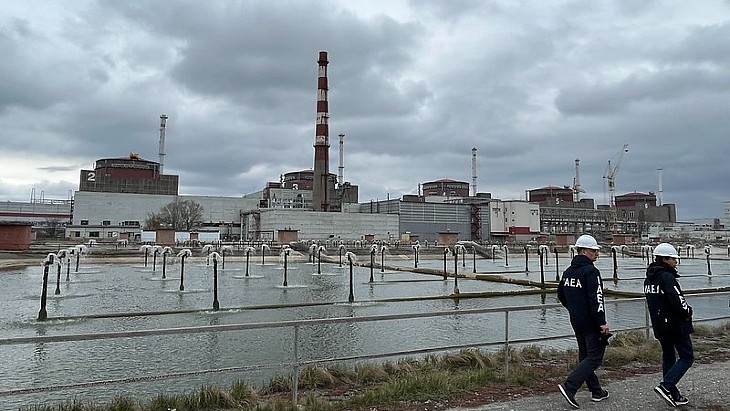IAEA welcomes action on back-up power at Zaporizhzhia
04 January 2024
The International Atomic Energy Agency (IAEA) says a new system to ensure an immediate supply of back-up electricity if the main external line fails is a significant safety development - but has also outlined a list of areas of the Zaporizhzhia nuclear power plant its experts want to inspect.
 IAEA teams have been on site since September 2022 (Image: IAEA)
IAEA teams have been on site since September 2022 (Image: IAEA)IAEA Director General Rafael Mariano Grossi said that frequent external power cuts - there have been eight since August 2022 - remained a "source of serious concern for safety and security" because electricity is required to cool its reactors and other essential functions.
The plant, on the frontline of Russian and Ukrainian forces, has just the one remaining 750 kV line, with one 330 kV back-up power line. But since mid-2023, the IAEA says, the back-up line has needed manual intervention to become operational. The IAEA says that work has now been carried out at the plant on back-up electrical transformers which, Grossi said: "Means that if the main power supply through the 750 kV switchyard is lost, the back-up line will automatically be able to provide electricity to the plant without manual, and hence delayed, intervention, provided it remains operational."
He added: "This is a significant development, as it enables independence and redundancy in the site’s power supply scheme, even though the overall off-site power situation ... remains extremely fragile. This solution will only be effective if the 330 kV power line remains available, which, as we know from experience, is far from guaranteed."
In the first update of the new year, the IAEA also detailed its requests for more access at the site, which has been under Russian military control since early March 2022. It said its experts stationed at the plant were still awaiting access to the rooftops of reactors which had been planned for 19 December, and it said "access to some parts of the ZNPP’s turbine halls continues to be restricted, including those areas of reactor units 3, 4 and 6 over the past week".
For the past two weeks, the agency says, its team has not been allowed to access the reactor halls of units 1, 2 and 6 - "the first time that IAEA experts have not been granted access to a reactor hall of a unit that was in cold shutdown".
They are also awaiting the maintainance schedule for 2024 and are "closely following developments" regarding boric acid deposits they observed during a walkdown in the containment building of unit 6, which the plant operators said was the result of a leak in one of the boric acid storage tanks. The IAEA said: "This type of leak can occur during the operation of a plant. However, this kind of event requires proper and timely attention, investigation and response from the operator, to prevent further and potentially more severe safety implications."
Progress continues on the installation of four more mobile diesel boilers at the site, to help generate additional steam for various nuclear safety functions. The plant currently has nine mobile boilers, of which at least eight have been operating, providing additional heating during the winter. Five of the six reactors at the nuclear power plant are in cold shut down, with one remaining in hot shutdown, where it produces heat for the plant and the nearby town of Energodar where most of the staff live.
IAEA teams stationed at Ukraine's other nuclear sites of Rivne, Khmelnitsky, South Ukraine power plants and Chernobyl "continue to report that nuclear safety and security is being maintained, despite wide-ranging missile attacks on Ukraine in the past week, which forced the IAEA experts at the Khmelnitsky NPP to take shelter three times". Those stationed at the Rivne plant were informed that a cruise missile flew close to the plant on 29 December.
Researched and written by World Nuclear News
No comments:
Post a Comment